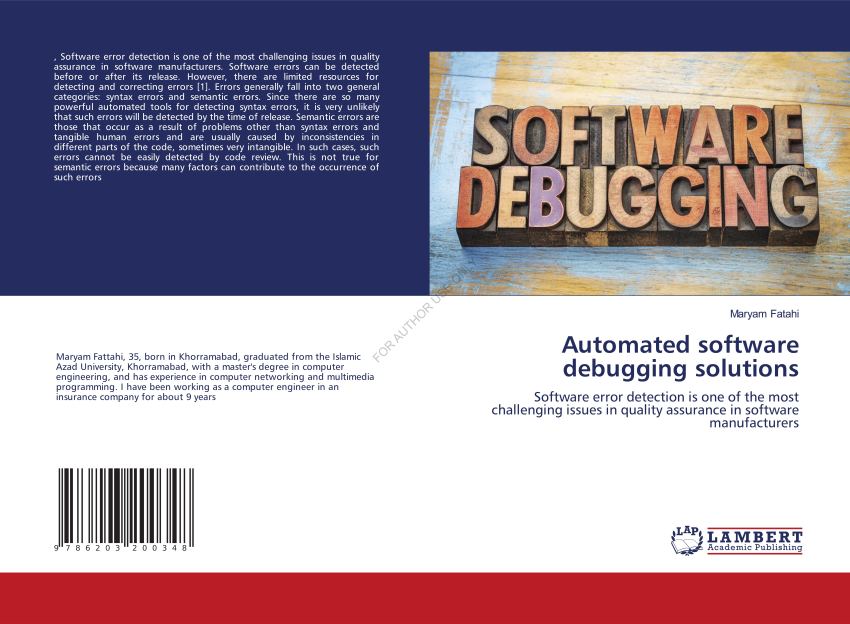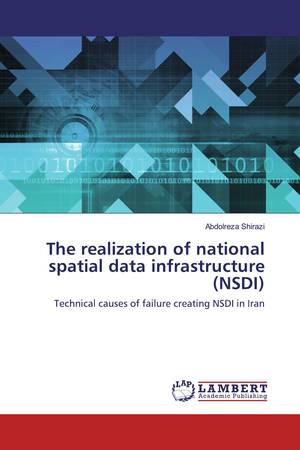کتاب Automated software debugging solutions
۱۴۰,۰۰۰ تومان Original price was: ۱۴۰,۰۰۰ تومان.۱۰۱,۳۶۰ تومانCurrent price is: ۱۰۱,۳۶۰ تومان.
| تعداد صفحات | 53 |
|---|---|
| شابک | 978-620-3-20034-8 |
| انتشارات |

کتاب Automated Software Debugging Solutions – راهحلهای نوین برای اشکالزدایی نرمافزار
کتاب Automated Software Debugging Solutions به بررسی رویکردهای پیشرفته و تکنولوژیهای نوین در زمینه اشکالزدایی نرمافزار میپردازد. این کتاب با ارائه ابزارها و راهکارهای خودکار، فرآیند رفع اشکال را برای برنامهنویسان و تیمهای توسعه سادهتر و کارآمدتر میکند.
درباره کتاب Automated Software Debugging Solutions
در دنیای پیچیده توسعه نرمافزار، اشکالزدایی یکی از زمانبرترین و پرچالشترین مراحل محسوب میشود. این کتاب، با معرفی سیستمها و روشهای خودکار، به توسعهدهندگان کمک میکند تا بهسرعت باگها و مشکلات نرمافزاری را شناسایی و برطرف کنند. نویسنده، با رویکردی تحلیلی و علمی، فناوریهای مختلف از جمله هوش مصنوعی، تحلیل کد و ابزارهای تست خودکار را پوشش میدهد.
موضوعات کلیدی کتاب
- مبانی اشکالزدایی خودکار: معرفی مفاهیم و ضرورت استفاده از راهکارهای خودکار در اشکالزدایی.
- ابزارها و تکنیکها: بررسی ابزارهای پیشرفتهای که فرایند دیباگ را تسریع و بهبود میبخشند.
- نقش هوش مصنوعی: تأثیر یادگیری ماشین و الگوریتمهای هوش مصنوعی در کشف و رفع خطاها.
- تحلیل کد: روشهای خودکار برای تحلیل و شناسایی نقاط آسیبپذیر در کدهای نرمافزاری.
- چالشها و آینده: موانع موجود در اشکالزدایی خودکار و پیشبینی آینده این حوزه.
ویژگیهای برجسته کتاب Automated Software Debugging Solutions
- رویکرد عملی و علمی: ارائه مفاهیم تئوری همراه با مثالهای کاربردی و مطالعات موردی.
- پوشش فناوریهای پیشرفته: تمرکز بر ابزارها و روشهای مدرن در اشکالزدایی نرمافزار.
- منبعی جامع: مناسب برای توسعهدهندگان، تیمهای تست و دانشجویان علوم کامپیوتر.
- زبان ساده و روان: کتاب به گونهای نوشته شده که خوانندگان با سطوح مختلف دانش بتوانند از آن بهرهمند شوند.
چرا کتاب Automated Software Debugging Solutions را بخوانید؟
اگر به دنبال راهحلهایی برای تسریع و بهبود فرآیند اشکالزدایی در پروژههای نرمافزاری خود هستید، این کتاب میتواند یک منبع ارزشمند باشد. با مطالعه این اثر، با جدیدترین تکنیکها و ابزارهای اشکالزدایی آشنا شده و میتوانید کیفیت کدهای خود را بهطور چشمگیری ارتقا دهید.
مخاطبان کتاب Automated Software Debugging Solutions
- توسعهدهندگان نرمافزار: برای بهبود مهارتهای اشکالزدایی و استفاده از ابزارهای خودکار.
- تیمهای تست و تضمین کیفیت: جهت افزایش دقت و سرعت در فرآیند تست نرمافزار.
- دانشجویان و محققان علوم کامپیوتر: بهعنوان یک منبع آموزشی جامع برای یادگیری مفاهیم اشکالزدایی.
- مدیران پروژههای نرمافزاری: برای کاهش هزینهها و افزایش بهرهوری تیمهای توسعه.
سفارش کتاب Automated Software Debugging Solutions
برای خرید کتاب Automated Software Debugging Solutions و استفاده از جدیدترین فناوریهای اشکالزدایی نرمافزار، به بخش فروشگاه سایت مراجعه کنید یا با ما تماس بگیرید. این کتاب گامی مؤثر برای بهبود فرآیند توسعه نرمافزار است.
برای کتاب “Automated Software Debugging Solutions” پرسش و پاسخهایی به شرح زیر تهیه شده است:
1. در فصل 1.2، “debugging” چیست؟ 🛠️
پاسخ: Debugging به فرایند شناسایی، تحلیل، و اصلاح خطاهای نرمافزاری اشاره دارد. در این فرایند، برنامهنویسان کد منبع را بررسی میکنند تا اشکالاتی که باعث رفتار نادرست برنامه میشوند را پیدا و اصلاح کنند.
2. چگونه Debugging نرمافزار در طول زمان تغییر کرده است؟ (فصل 1.3) ⏳
پاسخ: Debugging در طول زمان از روشهای دستی و ساده به رویکردهای خودکار و پیچیدهتر تکامل یافته است. ابزارهای مدرن اکنون امکان شبیهسازی، تجزیهوتحلیل خودکار و حتی پیشبینی خطاها را فراهم میکنند تا فرآیند اصلاح اشکالات سریعتر و کارآمدتر انجام شود.
3. در فصل دوم، “پیشبینی خطاها” چگونه توضیح داده میشود؟ 🔍
پاسخ: پیشبینی خطاها در این فصل به شبیهسازی و تحلیلهای آماری اشاره دارد که میتواند رفتار کد را بررسی کند و نواحی احتمالی که ممکن است خطا در آنها بروز کند را پیشبینی نماید. این رویکرد به کمک ابزارهای خودکار امکان پیشگیری از خطاها را پیش از وقوع فراهم میآورد.
4. مطالعات قبلی در زمینه debugging (فصل 2.3) چه جنبههایی را پوشش میدهند؟ 📚
پاسخ: در این بخش، نویسنده به بررسی تحقیقات و مطالعات گذشته در زمینه debugging میپردازد. این مطالعات عمدتاً بر روی تکنیکها و ابزارهای مختلف debugging متمرکز هستند که بهبود دقت و کارایی فرایند اشکالزدایی را هدف قرار دادهاند.
5. در فصل 3، “نمونهسازی کد منبع” به چه معناست؟ 💻
پاسخ: نمونهسازی کد منبع به نمایشی ساختاری از کد گفته میشود که میتواند برای تجزیه و تحلیل و پردازشهای خودکار استفاده شود. این فرایند معمولاً شامل تجزیه و تحلیل نحوه عملکرد کد در یک زبان برنامهنویسی خاص است.
6. در فصل 3.3، “درخت نحو انتزاعی (AST)” چه کاربردی دارد؟ 🌲
پاسخ: درخت نحو انتزاعی (AST) نمایشی گرافیکی از ساختار نحوی کد برنامه است که بهطور کامل ساختار زبانی برنامه را در قالب درخت نشان میدهد. این ابزار به شناسایی و تحلیل اشکالات کد و همچنین اعمال تغییرات بهینه در ساختار کد کمک میکند.
7. چگونه از الگوریتم رمزنگاری MD5 در فرایند debugging استفاده میشود؟ (فصل 3.7) 🔒
پاسخ: الگوریتم MD5 برای ایجاد “امضای دیجیتال” یا “fingerprint” از بخشهای مختلف کد استفاده میشود. این امضاءها برای شناسایی و تطبیق بخشهای مشابه یا خطاهای احتمالی در کد به کار میروند. این فرایند به شناسایی تغییرات ناخواسته یا مشکلات در نسخههای مختلف کد کمک میکند.
8. در فصل 4، “مقایسه زمان اجرا” چگونه ارزیابی میشود؟ ⏱️
پاسخ: در این بخش، زمان اجرایی روش پیشنهادی برای debugging با روشهای موجود مقایسه میشود. این مقایسه شامل ارزیابی زمان لازم برای اجرای الگوریتمهای مختلف و عملکرد آنها در شرایط واقعی است تا کارایی و سرعت روش جدید بررسی گردد.
9. چه تفاوتی بین دقت و کیفیت debugging پیشنهادی در فصل 4.5 وجود دارد؟ ⚖️
پاسخ: دقت به معنای توانایی یک روش در شناسایی خطاها بدون تولید نتیجههای اشتباه است، در حالی که کیفیت به مجموعه ویژگیهای مثبت و منفی روش debug اشاره دارد. در این فصل، مقایسهای انجام میشود که نشان میدهد روش پیشنهادی در مقایسه با روشهای قبلی در چه جنبههایی بهتر عمل میکند.
10. نتایج کلی و پیشنهادات در فصل 4-7 چه مباحثی را شامل میشود؟ 📊
پاسخ: این بخش به نتیجهگیری از تمام آزمایشها و تحقیقات انجامشده در کتاب پرداخته و پیشنهاداتی برای بهبود فرآیند debugging نرمافزار میدهد. این پیشنهادات شامل استفاده از الگوریتمهای پیشرفتهتر، بهبود ابزارهای موجود، و همچنین روشهای جدید برای کاهش زمان و هزینههای debugging است.
این پرسشها و پاسخها میتواند به خوانندگان کمک کند تا مفاهیم و موضوعات اصلی کتاب “Automated Software Debugging Solutions” را بهخوبی درک کنند.
| تعداد صفحات | 53 |
|---|---|
| شابک | 978-620-3-20034-8 |
| انتشارات |
محصولات مشابه
-
کتاب The Grey Stories
۱۴۰,۰۰۰ تومانOriginal price was: ۱۴۰,۰۰۰ تومان.۱۰۳,۶۰۰ تومانCurrent price is: ۱۰۳,۶۰۰ تومان. -
کتاب The realization of national spatial data infrastructure (NSDI)
۱۷۸,۰۰۰ تومانOriginal price was: ۱۷۸,۰۰۰ تومان.۱۳۱,۷۲۰ تومانCurrent price is: ۱۳۱,۷۲۰ تومان. -
کتاب An Introduction to Zero-Energy Building
۱۵۴,۰۰۰ تومانOriginal price was: ۱۵۴,۰۰۰ تومان.۱۱۱,۴۹۶ تومانCurrent price is: ۱۱۱,۴۹۶ تومان. -
کتاب Principles of Health Law
۵۹۲,۰۰۰ تومانOriginal price was: ۵۹۲,۰۰۰ تومان.۴۲۸,۶۰۸ تومانCurrent price is: ۴۲۸,۶۰۸ تومان.






